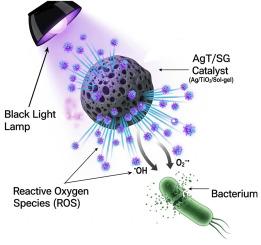Ag/TiO2光催化剂:对抗细菌耐药性的一种有前途的工具
IF 3.8
Q2 BIOTECHNOLOGY & APPLIED MICROBIOLOGY
引用次数: 0
摘要
材料的光活化正成为一种很有前途的策略,因为它允许病原体在不选择抗性菌株的情况下灭活。新药物或光活性剂的鉴定和开发是一个活跃的研究领域,其目的是为控制细菌感染提供更有效的治疗选择。采用溶胶-凝胶法(2AgT/SG和10AgT/SG)合成了负载在二氧化钛(TiO2)上的银基催化剂(Ag)(2%和10% w/w%)。AgT/SG催化剂的红外光谱表征显示了特有的钛谱带和Ti-Ag-O的不对称振动。x射线衍射鉴定这些催化剂具有明确的锐钛矿峰,代表有组织的结晶相。差示扫描量热数据显示AgT/SG催化剂的吸热峰较小,表明其熔点较低。热重分析表明,催化剂的质量损失最小。10AgT/SG催化剂在可见光(9 W)和黑暗条件下均表现出对大肠杆菌的抑菌活性。在黑光下,所有催化剂都被激活,仅在10分钟内就能去除大肠杆菌(ATCC 25922)和金黄色葡萄球菌(ATCC 25923)。这种快速的杀菌作用是由于活性氧(ROS)的大量产生,对被测试的菌株来说,这比实验开始时高出15%。这些结果证明了AgT/SG催化剂的潜力,提供了一种克服纯TiO2局限性的材料,并且快速起作用,为消毒和抗感染设备的实际应用铺平了道路。本文章由计算机程序翻译,如有差异,请以英文原文为准。

Ag/TiO2 photocatalysts: A promising tool in combating bacterial resistance
The photoactivation of materials is emerging as a promising strategy, as it allows pathogens to be inactivated without the selection of resistant strains. The identification and development of new drugs or photoactive agents represents an active field of research, with the aim of offering more effective therapeutic options for the control of bacterial infections. This study synthesized silver-based catalysts (Ag) (2 % and 10 % w/w%) supported on titanium dioxide (TiO2) by the sol-gel method (2AgT/SG and 10AgT/SG). Infrared spectrometric characterization of AgT/SG catalysts revealed characteristic titanium bands and the asymmetric vibration of Ti-Ag-O. X-ray diffraction identified that these catalysts have well-defined anatase peaks representing organized crystalline phases. The differential scanning calorimetry data shows smaller endothermic peaks for the AgT/SG catalysts, indicating a low melting point. Thermogravimetric analysis showed minimal loss of mass for the catalysts. The 10AgT/SG catalyst exhibited antibacterial activity against Escherichia coli under clear light (9 W) and in the dark, due to the Ag concentration. Under black light, all catalysts activated, eliminating both E. coli (ATCC 25922) and Staphylococcus aureus (ATCC 25923) in just 10 min. This rapid bactericidal action was attributed to the massive production of reactive oxygen species (ROS), which was 1500 % higher than at the beginning of the experiment for the tested strains. These results demonstrate the potential of AgT/SG catalysts, presenting a material that overcomes the limitations of pure TiO2 and, acts quickly, paving the way for practical applications in disinfection and infection-fighting devices.
求助全文
通过发布文献求助,成功后即可免费获取论文全文。
去求助
来源期刊

Biocatalysis and agricultural biotechnology
Agricultural and Biological Sciences-Agronomy and Crop Science
CiteScore
7.70
自引率
2.50%
发文量
308
审稿时长
48 days
期刊介绍:
Biocatalysis and Agricultural Biotechnology is the official journal of the International Society of Biocatalysis and Agricultural Biotechnology (ISBAB). The journal publishes high quality articles especially in the science and technology of biocatalysis, bioprocesses, agricultural biotechnology, biomedical biotechnology, and, if appropriate, from other related areas of biotechnology. The journal will publish peer-reviewed basic and applied research papers, authoritative reviews, and feature articles. The scope of the journal encompasses the research, industrial, and commercial aspects of biotechnology, including the areas of: biocatalysis; bioprocesses; food and agriculture; genetic engineering; molecular biology; healthcare and pharmaceuticals; biofuels; genomics; nanotechnology; environment and biodiversity; and bioremediation.
 求助内容:
求助内容: 应助结果提醒方式:
应助结果提醒方式:


